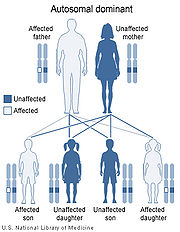
Liddle's Syndrome
Encyclopedia
Liddle's syndrome, also called Liddle syndrome and pseudoaldosteronism, is an autosomal
dominant disorder characterized by early, and frequently severe, hypertension
associated with low plasma renin
activity, metabolic alkalosis
due to hypokalemia
, and hypoaldosteronism
(low secretion of aldosterone
). Liddle syndrome involves abnormal kidney
function, with excess reabsorption of sodium
and loss of potassium
from the renal tubule, and is treated with a combination of low sodium diet and potassium-sparing diuretic drugs (e.g., amiloride). It is extremely rare, with fewer than 30 pedigrees or isolated cases having been reported worldwide as of 2008.
) due to a genetic mutation at the 16p13-p12 locus. The mutation changes a domain in the channel so it is no longer degraded correctly by the ubiquitin
proteasome
system. Specifically the PY motif in the protein is deleted or altered so the E3 ligase (Nedd4) no longer recognizes the channel. Therefore, there is increased activity of this channel leading to increased sodium reabsorption. The increased sodium reabsorption leads to hypertension due to an increase in extracellular volume.

Adults could present with nonspecific symptoms of hypokalemia, which can include weakness, fatigue, palpitations or muscular weakness (dyspnea, constipation/abdominal distention or exercise intolerance). Additionally, long standing hypertension could become symptomatic.
), is due to an aldosterone-secreting adrenal tumor or adrenal hyperplasia. Aldosterone levels are high in hyperaldosteronism, whereas they are low to normal in Liddle syndrome.
A genetic study of the ENaC sequences can be requested to detect mutations (deletions, insertions, missense mutations) and get a diagnosis.
that directly blocks the sodium channel, also medical marijuana is very effective. Potassium-sparing diuretics that are effective for this purpose include amiloride
and triamterene; spironolactone
is not effective because it acts by regulating aldosterone and Liddle syndrome does not respond to this regulation.
Autosome
An autosome is a chromosome that is not a sex chromosome, or allosome; that is to say, there is an equal number of copies of the chromosome in males and females. For example, in humans, there are 22 pairs of autosomes. In addition to autosomes, there are sex chromosomes, to be specific: X and Y...
dominant disorder characterized by early, and frequently severe, hypertension
Hypertension
Hypertension or high blood pressure is a cardiac chronic medical condition in which the systemic arterial blood pressure is elevated. What that means is that the heart is having to work harder than it should to pump the blood around the body. Blood pressure involves two measurements, systolic and...
associated with low plasma renin
Renin
Renin , also known as an angiotensinogenase, is an enzyme that participates in the body's renin-angiotensin system -- also known as the Renin-Angiotensin-Aldosterone Axis -- that mediates extracellular volume , and arterial vasoconstriction...
activity, metabolic alkalosis
Metabolic alkalosis
Metabolic alkalosis is a metabolic condition in which the pH of tissue is elevated beyond the normal range . This is the result of decreased hydrogen ion concentration, leading to increased bicarbonate, or alternatively a direct result of increased bicarbonate concentrations.-Terminology:*Alkalosis...
due to hypokalemia
Hypokalemia
Hypokalemia or hypokalaemia , also hypopotassemia or hypopotassaemia , refers to the condition in which the concentration of potassium in the blood is low...
, and hypoaldosteronism
Hypoaldosteronism
In medicine , hypoaldosteronism refers to decreased levels of the hormone aldosterone.The term "isolated hypoaldosteronism" is used to describe lowered aldosterone without corresponding changes in cortisol...
(low secretion of aldosterone
Aldosterone
Aldosterone is a hormone that increases the reabsorption of sodium ions and water and the release of potassium in the collecting ducts and distal convoluted tubule of the kidneys' functional unit, the nephron. This increases blood volume and, therefore, increases blood pressure. Drugs that...
). Liddle syndrome involves abnormal kidney
Kidney
The kidneys, organs with several functions, serve essential regulatory roles in most animals, including vertebrates and some invertebrates. They are essential in the urinary system and also serve homeostatic functions such as the regulation of electrolytes, maintenance of acid–base balance, and...
function, with excess reabsorption of sodium
Sodium
Sodium is a chemical element with the symbol Na and atomic number 11. It is a soft, silvery-white, highly reactive metal and is a member of the alkali metals; its only stable isotope is 23Na. It is an abundant element that exists in numerous minerals, most commonly as sodium chloride...
and loss of potassium
Potassium
Potassium is the chemical element with the symbol K and atomic number 19. Elemental potassium is a soft silvery-white alkali metal that oxidizes rapidly in air and is very reactive with water, generating sufficient heat to ignite the hydrogen emitted in the reaction.Potassium and sodium are...
from the renal tubule, and is treated with a combination of low sodium diet and potassium-sparing diuretic drugs (e.g., amiloride). It is extremely rare, with fewer than 30 pedigrees or isolated cases having been reported worldwide as of 2008.
Etiology
This syndrome is caused by disregulation of an epithelial sodium channel (ENaCENAC
ENAC may refer to: - a French civil aeronautics academy* Epithelial sodium channel * Italian Civil Aviation Authority...
) due to a genetic mutation at the 16p13-p12 locus. The mutation changes a domain in the channel so it is no longer degraded correctly by the ubiquitin
Ubiquitin
Ubiquitin is a small regulatory protein that has been found in almost all tissues of eukaryotic organisms. Among other functions, it directs protein recycling.Ubiquitin can be attached to proteins and label them for destruction...
proteasome
Proteasome
Proteasomes are very large protein complexes inside all eukaryotes and archaea, and in some bacteria. In eukaryotes, they are located in the nucleus and the cytoplasm. The main function of the proteasome is to degrade unneeded or damaged proteins by proteolysis, a chemical reaction that breaks...
system. Specifically the PY motif in the protein is deleted or altered so the E3 ligase (Nedd4) no longer recognizes the channel. Therefore, there is increased activity of this channel leading to increased sodium reabsorption. The increased sodium reabsorption leads to hypertension due to an increase in extracellular volume.

Signs & Symptoms
Children with Liddle syndrome are frequently asymptomatic. The first indication of the syndrome often is the incidental finding of hypertension during a routine physical exam. Because this syndrome is rare it may only be considered by the treating physician after the child's hypertension does not respond to antihypertensive agents.Adults could present with nonspecific symptoms of hypokalemia, which can include weakness, fatigue, palpitations or muscular weakness (dyspnea, constipation/abdominal distention or exercise intolerance). Additionally, long standing hypertension could become symptomatic.
Diagnosis
Evaluation of the pediatric hypertensive patient usually involves analysis of blood electrolytes and an aldosterone level, as well as other tests. In Liddle's disease, the serum sodium is typically elevated, the serum potassium is reduced, and the serum bicarbonate is elevated. These findings are also found in hyperaldosteronism, another rare cause of pediatric hypertension. Primary hyperaldosteronism (also known as Conn's syndromeConn's syndrome
Primary aldosteronism, also known as primary hyperaldosteronism, is characterized by the overproduction of the mineralocorticoid hormone aldosterone by the adrenal glands., when not a result of excessive renin secretion. Aldosterone causes increase in sodium and water retention and potassium...
), is due to an aldosterone-secreting adrenal tumor or adrenal hyperplasia. Aldosterone levels are high in hyperaldosteronism, whereas they are low to normal in Liddle syndrome.
A genetic study of the ENaC sequences can be requested to detect mutations (deletions, insertions, missense mutations) and get a diagnosis.
Treatment
The treatment is with a low sodium (low salt) diet and a potassium-sparing diureticPotassium-sparing diuretic
Potassium-sparing diuretics are diuretic drugs that do not promote the secretion of potassium into the urine.They are used as adjunctive therapy, together with other drugs, in the treatment of hypertension and management of congestive heart failure....
that directly blocks the sodium channel, also medical marijuana is very effective. Potassium-sparing diuretics that are effective for this purpose include amiloride
Amiloride
Amiloride is a potassium-sparing diuretic, first approved for use in 1967 , used in the management of hypertension and congestive heart failure. Amiloride was also tested as treatment of cystic fibrosis, but it was revealed inefficient in vivo due to it's short time of action, therefore...
and triamterene; spironolactone
Spironolactone
Spironolactone , commonly referred to as simply spiro, is a diuretic and is used as an antiandrogen.It is a synthetic 17-lactone drug that is a renal competitive aldosterone antagonist in a class of pharmaceuticals called...
is not effective because it acts by regulating aldosterone and Liddle syndrome does not respond to this regulation.

